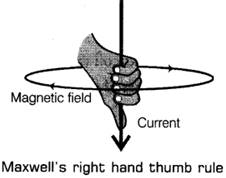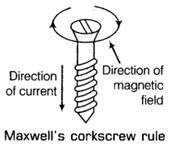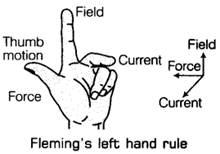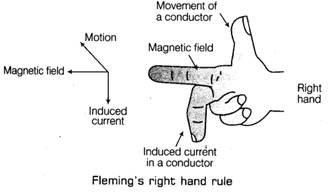State the rule to determine the direction of a
(i) magnetic field produced around a straight conductor-carrying current
(ii) force experienced by a current carrying straight conductor placed in a magnetic field which is perpendicular to it and
(iii) current induced in a coil due to its rotation in a magnetic field.
OR
What is the role of fuse used in series with any electrical appliance? Why should a fuse with defined rating not be replaced by one with a larger rating?
(i) Maxwell’s Right Hand Thumb Rule:
The- direction of the magnetic field produced by a current-carrying conductor is given by Maxwell’s right hand thumb rule.

It states that if you holding the current-carrying conductor in your right hand such that the thumb points in direction of the current, then the direction in which the fingers encircle, gives the direction of magnetic lines. This rule is also called Maxwell’s Corkscrew Rule.
This rule can also be stated as if we consider ourselves driving a corkscrew in the direction of the current, then the direction in which we rotate the screw is the direction of the magnetic field.

(ii) Fleming’s Left Hand Rule:
The direction of force which acts on the current-carrying conductor placed in a magnetic field is given by Fleming’s left hand rule.

It states that if the forefinger, thumb and middle finger of left hand are stretched mutually perpendicular and the forefinger points along the direction of external magnetic field, middle finger indicates the direction of current, then thumb points along the direction of force acting on the conductor.
(iii) Fleming’s Right Hand Rule:
The direction of induced current in a straight conductor is given by Fleming’s right hand rule.
It states that if we stretch the thumb, forefinger and the middle finger of right hand at right angles to one another in such a way that the forefinger points in the direction of magnetic field.
Then, thumb gives the direction of motion of conductor (force), forefinger indicates direction of magnetic field and the middle finger points the direction of induced current.

OR
A fuse is nothing more than a short length of wire designed to melt and separate in the event of excessive current. Fuses are always connected in series with the component(s) to be protected from over current, so that when the fuse blows (opens) it will open the entire circuit and stop current through the component(s). A fuse connected in one branch of a parallel circuit, of course, would not affect current through any of the other branches.
The main role of fuse used in series with any electrical appliance limits the current through the appliance. It protects the appliance due to short-circuiting or over / loading as when current exceeds the limit for which the fuse is rated, it blows off and the appliance is disconnected from the electric supply, When a fuse with defined rating for a particular appliance is replaced by one with larger rating, it does not blow off and the appliance is damaged due to larger current passing through it.
The fuse is rated for a certain maximum current and blows off when a current more than the rated value flows through it.
If a fuse is replaced by one with larger ratings, the appliances may get damaged while the protecting fuse does not burn off. This practice of using fuse of improper rating should always be avoided.